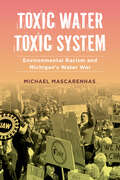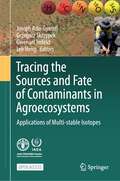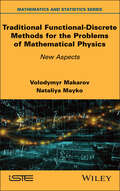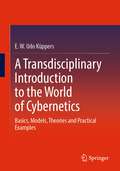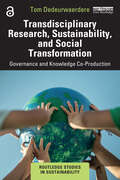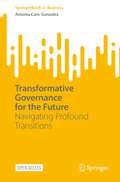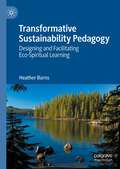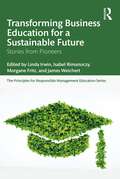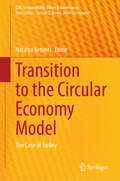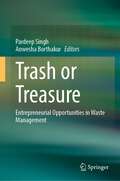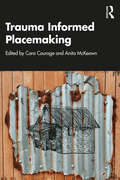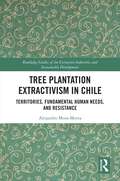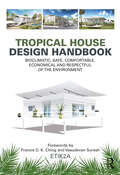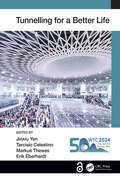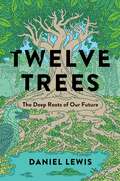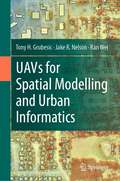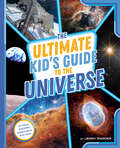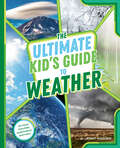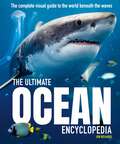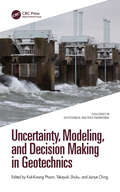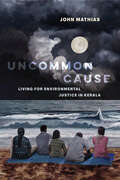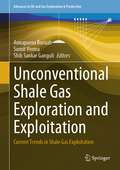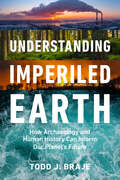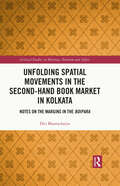- Table View
- List View
Toxic Water, Toxic System: Environmental Racism and Michigan's Water War
by Prof. Michael MascarenhasThe tireless resistance of local communities fighting for ownership of America’s third largest water system Toxic Water, Toxic System exposes the consequences of a seemingly anonymous authoritarian state willing to maintain white supremacy at any cost—including poisoning an entire city and shutting off water to thousands of people. Weaving together narratives of frontline activists along with archival data, Michael Mascarenhas provides a powerful exploration of the political alliances and bureaucratic mechanisms that uphold inequality. Drawing from three years of ethnographic fieldwork in Flint and Detroit, this book amplifies the voices of marginalized communities, particularly African American women, whose perspectives and labor have been consistently overlooked. Toxic Water, Toxic System offers a fresh perspective on the ties between urban austerity policies, environmental harm, and the advancement of white supremacist agendas in predominantly Black and brown cities.
Tracing the Sources and Fate of Contaminants in Agroecosystems: Applications of Multi-stable Isotopes
by Lee Heng Joseph Adu-Gyamfi Grzegorz Skrzypek Gwenaël ImfeldThe objective of this open access book is to present protocols, methodologies, and standard operating procedures (SOPs) used for the identification of sources, transport, and fate of agro-contaminants and illustrate them with several case studies of successful applications. The Soil and Water Management & Crop Nutrition (SWMCN) Subprogramme of the Joint Food and Agriculture Organization (FAO)/International Atomic Energy Agency (IAEA) Centre of Nuclear Techniques in Food and Agriculture, through a Coordinated Research Project (CRP) in partnership with national and international research institutes, developed and evaluated a set of analytical techniques (the toolbox). The toolbox integrates multiple isotope tracers that provide information on the origins and pathways of multiple pollutants through agro-ecosystems, thereby providing more accurate guidance on mitigations. However, land management strategies to address and control the transport of pollutants from soil to water bodies remain the shared responsibility of farm and aquaculture operators, agro-chemical manufacturers, and policymakers in food and agriculture as well as the mining sectors. This book is structured into eight chapters covering (i) an overview of the book’s content, (ii) guidelines for designing water sampling programmes, (iii) the use of mixing models applicable to tracers for water pollution studies, (iv) compound-specific isotope analyses to investigate pesticide degradation in agricultural catchments, (v) the use of stable oxygen isotope composition of phosphate to investigate phosphorous in soil-plant continuum, (vi) the use of stable sulphur isotopes to disentangle agro-pollutants from other contaminants, (vii) nuclear tools used in sediment source apportionment, and (viii) the conclusions and perspectives forward. The book offers up-to-date information, and we hope it is a great source of information for students, researchers, and policymakers. The SWMCN subprogramme thanks all the contributors involved in the preparation of this publication.
Traditional Functional-Discrete Methods for the Problems of Mathematical Physics: New Aspects
by Volodymyr Makarov Nataliya MaykoThis book is devoted to the construction and study of approximate methods for solving mathematical physics problems in canonical domains. It focuses on obtaining weighted a priori estimates of the accuracy of these methods while also considering the influence of boundary and initial conditions. This influence is quantified by means of suitable weight functions that characterize the distance of an inner point to the boundary of the domain. New results are presented on boundary and initial effects for the finite difference method for elliptic and parabolic equations, mesh schemes for equations with fractional derivatives, and the Cayley transform method for abstract differential equations in Hilbert and Banach spaces. Due to their universality and convenient implementation, the algorithms discussed throughout can be used to solve a wide range of actual problems in science and technology. The book is intended for scientists, university teachers, and graduate and postgraduate students who specialize in the field of numerical analysis.
A Transdisciplinary Introduction to the World of Cybernetics: Basics, Models, Theories and Practical Examples
by E. W. KüppersThis introduction to the world of cybernetics provides the basics and discusses the most important thought leaders, models as well as theories. Practical examples from the fields of biology, ecology, technology, society, and politics are used to illustrate the theoretical material. Questions at the end of the chapters stimulate reflection, and the author does not owe the answers. A central theme in all cybernetic considerations and a guiding theme of the book are information exchange and communication.
Transdisciplinary Research, Sustainability, and Social Transformation: Governance and Knowledge Co-Production (Routledge Studies in Sustainability)
by Tom DedeurwaerdereThis book addresses the gap in the existing literature on the governance of transdisciplinary research partnerships in transformational sustainability research by exploring the governance of knowledge co-production in coupled socio-ecological system dynamics. Multiple social and ecological crises raise new cross-sectoral research questions that call for an evolution in contemporary science in the direction of society-wide knowledge co-production on sustainability transformations of interdependent social and ecological systems. This book proposes a new approach to this based on enabling capacities for collaboration among scientific researchers and societal actors with diverse values, perspectives, and research interests. By drawing upon the thriving literature on the conditions for community and multistakeholder-driven collective action, the analysis sheds new light on the governance arrangements for organizing so-called transdisciplinary research partnerships for sustainability. This book identifies robust conditions that lead to effective collaborative research with societal actors and digs deeper into capacity building for partnership research through fostering social learning on sustainability values among research partners and organizing training and knowledge exchange at institutions of higher education. The book proposes solutions for addressing collective action challenges in transdisciplinary partnerships in an accessible and broadly interdisciplinary manner to a large audience of sustainability scholars and practitioners. It will be of interest to students and researchers in the fields of sustainable development, social ecological transitions, and science policy, while also being a useful resource for engineers, QSE managers, and policymakers.
Transdisciplinary Research, Sustainability, and Social Transformation: Governance and Knowledge Co-Production (Routledge Studies in Sustainability)
by Tom DedeurwaerdereThis book addresses the gap in the existing literature on the governance of transdisciplinary research partnerships in transformational sustainability research by exploring the governance of knowledge co-production in coupled socio-ecological system dynamics.Multiple social and ecological crises raise new cross-sectoral research questions that call for an evolution in contemporary science in the direction of society-wide knowledge co-production on sustainability transformations of interdependent social and ecological systems. This book proposes a new approach to this based on enabling capacities for collaboration among scientific researchers and societal actors with diverse values, perspectives, and research interests. By drawing upon the thriving literature on the conditions for community and multistakeholder-driven collective action, the analysis sheds new light on the governance arrangements for organizing so-called transdisciplinary research partnerships for sustainability. This book identifies robust conditions that lead to effective collaborative research with societal actors and digs deeper into capacity building for partnership research through fostering social learning on sustainability values among research partners and organizing training and knowledge exchange at institutions of higher education.The book proposes solutions for addressing collective action challenges in transdisciplinary partnerships in an accessible and broadly interdisciplinary manner to a large audience of sustainability scholars and practitioners. It will be of interest to students and researchers in the fields of sustainable development, social ecological transitions, and science policy, while also being a useful resource for engineers, QSE managers, and policymakers.The Open Access version of this book, available at http://www.taylorfrancis.com, has been made available under a Creative Commons Attribution-Non Commercial-No Derivatives (CC-BY-NC-ND) 4.0 license.
Transformative Governance for the Future: Navigating Profound Transitions (SpringerBriefs in Business)
by Antonia Caro-GonzalezThis open access book helps actors who are committed to change unlock true innovative potential for the common good in their organizations. Innovation and change processes are not linear. Hence, this book presents a novel way to manage complexity. The author introduces readers to a comprehensive change management framework, the Eoh-for-Good blueprint methodology. It presents the method and discusses how it can be used to support collaboration, overcome challenges and achieve lasting changes in organizations with a 360-degree approach combining top-down, middle-round and bottom-up collaborative perspectives.
Transformative Sustainability Pedagogy: Designing and Facilitating Eco-Spiritual Learning
by Heather BurnsThis book offers stories and tools for designing and facilitating transformative sustainability pedagogy and explores how educators can intentionally design and facilitate eco-spiritual learning that promotes healing and wholeness. In these times of accelerating climate change and systemic injustice, we need learning spaces that both challenge our unsustainable dominant paradigms and support us in re-learning how to live in relational and regenerative ways. Rooted in the paradigm of interconnection and relationality, this book offers practical ways to design and facilitate learning toward more just, ecological, and spiritual ways of being. The author weaves together a variety of personal stories of teaching and learning, an exploration of how new science can be applied to transformative sustainability pedagogy, and eco-spiritual practices to help educators nurture wholeness and connection in themselves and in learning spaces.
Transforming Business Education for a Sustainable Future: Stories from Pioneers (The Principles for Responsible Management Education Series)
by Linda Irwin Isabel Rimanoczy Morgane Fritz James WeichertAs the impact of climate change becomes more evident and dire, business leaders, educators, students, and academic leaders are deciding what they need to change and do to survive and thrive in a new and dramatically different environment. This book sets out how to transform business education and integrate sustainability practices into curriculum and a wider academic culture. While some universities around the globe are still teaching business practices that have contributed to human and environmental crises, pioneering educators and higher education institutions are researching, developing, and implementing programs to transform business education and practices. With stories from 26 administrators, researchers, and faculty across the globe, this book inspires business educators with innovative tools and creative solutions to address challenges in the business world and society. These pioneers are helping students and business ventures change the way they conduct business to survive and thrive in a fast-changing global environment. Their unique and personal journeys offer tools, models, lessons-learned, and inspiration for change. The book will both inspire and guide faculty members, administrators, students, and alumni to transform business education for a sustainable future.
Transition to the Circular Economy Model: The Case of Turkey (CSR, Sustainability, Ethics & Governance)
by Natalya KetenciThis edited volume provides a multisectoral, multidisciplinary analysis of the circular economy in Turkey. The chapters delve into different segments of the economy, monitoring the progress of the transition to circularity as it is occurring. Written by experts in the circular economy, chapters touch on different aspects of the sustainability transition—from AI and entrepreneurship to luxury fashion to green finance. Chapters also refer directly to applicable UN Sustainable Development Goals, noting the progress made towards related development targets. This volume will be of use to students, academicians, experts, and professionals interested and working on different aspects of circular and green economies.
Trash or Treasure: Entrepreneurial Opportunities in Waste Management
by Pardeep Singh Anwesha BorthakurIn this book, we have contributions from experts working on diverse aspects of waste management and waste entrepreneurship with an aim to contribute toward a holistic understanding of the existing and forthcoming waste handling challenges. Waste entrepreneurship refers to the practice of creating and operating businesses that aim to address the problem of waste management. It signifies businesses that are dedicated to finding innovative solutions for managing waste and plays a crucial role in building a sustainable future. Waste entrepreneurs identify waste as a valuable resource and use state-of-the-art tactics to reduce, reuse, recycle, and re-purpose it. By developing new technologies, services, and products that help reduce waste and recycle materials, they can create new economic opportunities while simultaneously reducing the environmental impact of waste. The primary audience of this book are researchers (from a wide range of disciplinary backgrounds) working in the field of waste management (especially E-waste, Plastics, Paper and Cardboard Waste, Organic Waste, and Construction and Demolition Waste) and environmental sustainability. This book also contains descriptions of various facets of waste entrepreneurship from different countries which will be helpful for different entrepreneurs looking for business opportunities in the waste management sector, NGOs, government agencies, international agencies, and new researchers working in the related fields. In particular, the book could provide start-up ideas to the enthusiastic readers.
Trauma Informed Placemaking
by Courage, Edited by Cara Anita McKeownTrauma Informed Placemaking offers an introduction to understanding trauma and healing in place. It offers insights that researchers and practitioners can apply to their place-based practice, learning from a global cohort of place leaders and communities.The book introduces the ethos and application of the trauma-informed approach to working in place, with references to historical and contemporary trauma, including trauma caused by placemakers. It introduces the potential of place and of place practitioners to heal. Offering 20 original frameworks, toolkits and learning exercises across 33 first- and third-person chapters, multi-disciplinary insights are presented throughout. These are organised into four sections that lead the reader to an awareness of how trauma and healing operate in place. The book offers a first gathering of the current praxis in the field – how we can move from trauma in place to healing in place – and concludes with calls to action for the trauma-informed placemaking approach to be adopted.This book will be essential reading for students, researchers and practitioners interested in people and places, from artists and architects, policy makers and planners, community development workers and organisations, placemakers, to local and national governments. It will appeal to the disciplines of human geography, sociology, politics, cultural studies, psychology and to placemakers, planners and policymakers and those working in community development.
Tree Plantation Extractivism in Chile: Territories, Fundamental Human Needs, and Resistance (Routledge Studies of the Extractive Industries and Sustainable Development)
by Alejandro Mora-MottaThis book examines how extractivism transforms territories and affects the well-being of rural people, drawing on in-depth fieldwork conducted on tree plantations in Chile.The book argues that pine and eucalyptus monoculture plantations in southern Chile are a form of extractivism representing a mode of nature appropriation that captures large amounts of natural resources to produce wooden-based raw materials with little processing and an export-oriented focus. The book discusses the nexus of extractivism, territorial transformations, well-being, and emerging resistances using a participatory action research methodological approach in the Region of Los Ríos, southern Chile. The findings show how the configuration of an extractivist logging enclave generated a substantial and irrevocable reordering of human-nature relations, resulting in the territorial and ontological occupation of rural places that disrupted the fundamental human needs of peasants and indigenous people. The book maintains that Chile's green growth development approach does not challenge the consolidated tree plantation enclave controlled by large multinationals. Instead, green growth legitimises the extractivist logic. The book draws parallels with other countries and regions to contribute to wider debates surrounding these topics.This book will be of great interest to students and scholars of the extractive industries, development studies, political ecology, and natural resource governance.
Tropical House Design Handbook: Bioclimatic, Safe, Comfortable, Economical and Respectful of the Environment
by Etik2aPacked with accessible information, this book covers all the technical and practical aspects of home design in tropical environments. . It begins by outlining the prerequisites needed to understand the issues involved (climate, heat, thermal comfort, etc.) and discusses the solutions offered by traditional housing. It then identifies current solutions for protecting buildings and their occupants from solar radiation and external heat, while promoting bioclimatic and environmentally friendly approaches. . The economic viability of the solutions identified is discussed, as are the advantages and disadvantages of the materials, depending on the context and standards in force. . Numerous examples illustrate how buildings can be adapted to local realities, from the avant-garde creations of Jean Prouvé to those of today’s architects who are committed to sustainable development, as well as specific projects incorporating the recommendations made in this book. More than 460 photos, drawings, diagrams, tables, maps, house plans, logos and pictograms illustrate this reference work for all those involved in construction in tropical regions, particularly students in the field and, more generally, anyone – from professionals to private individuals – looking for useful information on this subject.
Tunnelling for a Better Life
by Jinxiu YanTunnelling for a Better Life contain the contributions presented at the ITA-AITES World Tunnel Congress 2024, which was held from 19-25 April 2024 in Shenzhen, China. As urbanization accelerates, the pivotal role of tunnels and underground spaces in fostering environmental sustainability and improving quality of life becomes ever more pronounced. These underground structures serve as sustainable solutions to the challenges posed by rapid urban growth. By seamlessly integrating into urban landscapes, they alleviate congestion, reduce pollution, and enhance overall mobility, thus contributing to a greener and more sustainable urban environment. Moreover, tunnels and underground works provide vital support for various urban functions, such as accommodating economic activities, providing safe shelters during emergencies or disasters, and facilitating efficient utility management. They address immediate urban needs and lay the foundation for a better and more resilient future.By focusing on the latest trends in tunnelling and underground engineering, and looking ahead to the era of low-carbon and intelligent technology, the papers in this book illustrate the transformative potential of tunnels and underground works in shaping a better life for present and future generations. The contributions cover a comprehensive range of topics on tunnel engineering, showcasing the latest advancements, insights, and innovations across the following areas:1. Planning and General Aspects2. Design and Methodology3. Geotechnics, Geology and Geophysical Prospecting4. Ground Stability and Consolidation5. Support and Lining6. Conventional Tunnelling7. Mechanized Tunneling (TBM, shield)8. Immersed Tunnels9. Waterproofing and Drainage10. Instrumentation and Monitoring/ Testing and Inspection11. Digital and Information Technology12. Machine Learning13. Underground Caverns/Underground Space Use14. Operational Safety, Maintenance and Repair15. Contractual Practices and Risk ManagementTunnelling for a Better Life is a must-read for professionals, engineers, owners, and other stakeholders worldwide in tunnelling and underground engineering.
Twelve Trees: The Deep Roots of Our Future
by Daniel LewisA compelling global exploration of nature and survival as seen via a dozen species of trees that represent the challenges facing our planet, and the ways that scientists are working urgently to save our forests and our future.The world today is undergoing the most rapid environmental transformation in human history—from climate change to deforestation. Scientists, ethnobotanists, indigenous peoples, and collectives of all kinds are closely studying trees and their biology to understand how and why trees function individually and collectively in the ways they do. In Twelve Trees, Daniel Lewis, curator and historian at one of the world&’s most renowned research libraries, travels the world to learn about these trees in their habitats. Lewis takes us on a sweeping journey to plant breeding labs, botanical gardens, research facilities, deep inside museum collections, to the tops of tall trees, underwater, and around the Earth, journeying into the deserts of the American west and the deep jungles of Peru, to offer a globe-spanning perspective on the crucial impact trees have on our entire planet. When a once-common tree goes extinct in the wild but survives in a botanical garden, what happens next? How can scientists reconstruct lost genomes and habitats? How does a tree store thousands of gallons of water, or offer up perfectly preserved insects from millions of years ago, or root itself in muddy swamps and remain standing? How does a 5,000-year-old tree manage to live, and what can we learn from it? And how can science account for the survival of one species at the expense of others? To study the science of trees is to study not just the present, but the story of the world, its past, and its future. Note—species include: * The Lost Tree of Easter Island (Sophora toromiro) * The coast redwood (Sequoia sempervirens) * Hymenaea protera [a fossil tree] * The Longleaf pine (Pinus palustris) * East Indian sandalwood (Santanum album) * The Bristlecone pine (Pinus longaeva) * West African ebony (Diospyros crassiflora) * The Tasmanian blue gum eucalyptus (Eucalyptus globulus) * Olive tree (Olea europaea) * Baobab (Adansonia digitata) * the kapok tree (Ceiba pentandra) * The bald cypress (Taxodium distichum)
UAVs for Spatial Modelling and Urban Informatics
by Tony H. Grubesic Jake R. Nelson Ran WeiThis book aims to provide a wide range of real-world applications in using unmanned aerial vehicles (UAVs) for geographic observation, spatial modeling, and urban informatics. Specifically, UAVs are incredibly effective platforms for connecting people, places, and technology. This book explores the utility of UAVs for monitoring, measuring, and improving urban infrastructure systems, urban sustainability, and the urban environment. The dynamism of cities provides opportunities for economic, social, and environmental change, but benchmarking and measuring cities continues to be challenging. This challenge is due, at least in part, to a lack of monitoring systems that can collect and analyze data at a granular enough scale to capture the nuance of local phenomena. UAVs offer a promising mechanism to fill this niche, serving as a measurement platform that can rapidly and inexpensively collect data and monitor change in cities. However, their use is fraught with social, operational, regulatory, and technical challenges for successful deployments. This book provides a resource for urbanists (e.g., planners, geographers, sociologists, epidemiologists, engineers), educators, and students who work with geographic information and seek to enhance these data using data and information from unmanned aerial vehicles. At the same time, we provide operational and methodological frameworks for carrying out these advanced analyses in a manner that considers the challenges of incorporating UAVs in research within the urban environment. We provide six unique applications of UAVs for urban analysis, detailing relevant policy and empirical questions, UAV mission parameters, data collection, spatial modeling, and the associated empirical results. Further, we discuss how best to integrate these results into actionable geospatial intelligence and policy development to improve city infrastructure systems, sustainability, the environment, and neighborhood quality.
The Ultimate Kid's Guide to the Universe: At-Home Activities, Experiments, and More! (The Ultimate Kid's Guide to...)
by Jenny MarderWith stunning photos of outer space and easy at-home experiments, this is the only guide kids need on their journey of learning about all things astronomy: the stars, the planets, the moon, and so much more!Buckle up and let Jenny Marder, a senior writer for NASA, be your guide to the universe! First stop: the moon!A perfect read for kids, just in time for the April 2024 total solar eclipse!
The Ultimate Kid's Guide to Weather: At-Home Activities, Experiments, and More! (The Ultimate Kid's Guide to...)
by Jenny MarderWith stunning photos of Earth's wildest weather and easy at-home STEM activities, this is the only guide kids need on their journey of learning about all things meteorology.Buckle up and let Jenny Marder, a senior writer for NASA, be your guide through the Earth&’s atmosphere! First stop: the stratosphere!
The Ultimate Ocean Encyclopedia: The complete visual guide to ocean life (Ultimate Encyclopedia #3)
by Jon RichardsThis new and unique encyclopedia is an amazing new visual guide to the planet's seas and oceans. Using amazing photography and cutting edge CG images, readers can explore every aspect of our oceans, from the submarines that explore them to the vast array of life that lives in them.Discover the plants and animals that exist in every ocean habitat, from the shore to the lowest trenches. You'll learn about sealife including crustaceans, coral, anenomes, every kind of fish, as well as mammals like sealions, dolphins and orcas, and ocean giants like the Blue Whale.Readers will also be able to see how humans have lived with the ocean for millennia, and how our actions today can doom or save our amazing oceans in the years ahead. This brand new encyclopedia is packed with stunning images that truly bring the wonder and majesty of the world's oceans to life.
Uncertainty, Modeling, and Decision Making in Geotechnics
by Kok-Kwang Phoon, Takayuki Shuku, and Jianye ChingUncertainty, Modeling, and Decision Making in Geotechnics shows how uncertainty quantification and numerical modeling can complement each other to enhance decision-making in geotechnical practice, filling a critical gap in guiding practitioners to address uncertainties directly. The book helps practitioners acquire a working knowledge of geotechnical risk and reliability methods and guides them to use these methods wisely in conjunction with data and numerical modeling. In particular, it provides guidance on the selection of realistic statistics and a cost-effective, accessible method to address different design objectives, and for different problem settings, and illustrates the value of this to decision-making using realistic examples. Bringing together statistical characterization, reliability analysis, reliability-based design, probabilistic inverse analysis, and physical insights drawn from case studies, this reference guide from an international team of experts offers an excellent resource for state-of-the-practice uncertainty-informed geotechnical design for specialist practitioners and the research community.
Uncommon Cause: Living for Environmental Justice in Kerala
by John MathiasHow can activists strike a balance between fighting for a cause and sustaining relationships with family, friends, and neighbors? Uncommon Cause follows environmental justice activists in Kerala, India, as they seek out, avoid, or strive to overcome conflicts between their causes and their community ties. John Mathias finds two contrasting approaches, each offering distinct possibilities for an activist life. One set of activists repudiates community ties and resists normative pressures; for them, environmental justice becomes a way of transcending all local identities and affiliations, even humanity itself. Other activists seek to ground their activism in community belonging, to fight for their own people. Each approach produces its own dilemmas and offers its own insights into ethical tensions we all face between taking a stand and standing with others. In sharing Kerala activists’ diverse stories, Uncommon Cause offers a fresh perspective on environmental ethics, showing that environmentalism, even as it looks beyond merely human concerns, is still fundamentally about how we relate to other people.
Unconventional Shale Gas Exploration and Exploitation: Current Trends in Shale Gas Exploitation (Advances in Oil and Gas Exploration & Production)
by Annapurna Boruah Sumit Verma Shib Sankar GanguliFrom the geological mysteries of shale formations to cutting-edge techniques in gas extraction, this book unveils the essential knowledge to harness the potential of shale gas. The book integrates various data types such as outcrop, well logs, core data, etc.) for hydrofracturing—from basin-scale to nano-pore-scale. The book included a wealth of information on the latest advancements, industry practices, environmental considerations, policies, and more. In a world increasingly conscious of environmental concerns, "Cleaner Energy from the Earth" offers a fresh perspective on the utilization of shale gas as a cleaner fossil fuel alternative. This comprehensive book takes the reader on a captivating journey through the science, technology, and innovation driving shale gas exploration and exploitation towards a greener future. Whether you're a seasoned industry professional, a student, or a curious reader, this book provides a comprehensive and accessible resource for all levels of expertise.
Understanding Imperiled Earth: How Archaeology and Human History Can Inform Our Planet's Future
by Todd J. BrajeA unique introduction to how understanding archaeology can support modern-day sustainability efforts, from restoring forested land to developing fire management strategiesAn essential and hopeful book for climate-conscious readersThe world faces an uncertain future with the rise of climate change, biodiversity loss, deforestation, overfishing, and other threats. Understanding Imperiled Earth meets this uncertainty head-on, presenting archaeology and history as critical guides to addressing the modern environmental crisis.Anthropologist Todd J. Braje draws connections between deep history and today's hot-button environmental news stories to reveal how the study of the ancient past can help build a more sustainable future. The book covers a diverse array of interconnected issues, including: how modern humans have altered the natural world conservation work of Indigenous communitiesextinction of megafauna like dire wolves and woolly rhinocerosthe risk of deforestation highlighted by Notre Dame's destructionthe extinction crisis reflected by endangered bird species in Hawai'ifish scarcity driving demand and price, like the single blue-fin tuna fish that sold for three million dollarsimportance of "action archaeology" Braje examines how historical roots offer a necessary baseline for a healthier Earth, because understanding how the planet used to be is fundamental to creating effective restoration efforts moving forward through urban forests, sustainable food webs, and more. Understanding Imperiled Earth offers an illuminating, hopeful, and actionable approach to some of the world's most urgent problems.
Unfolding Spatial Movements in the Second-Hand Book Market in Kolkata: Notes on the Margins in the Boipara (Critical Studies in Heritage, Emotion and Affect)
by Diti BhattacharyaThis insightful book unfolds the boipara, exploring the acts of thinking and writing about space and place in the context of recent key conversations at the intersections of cultural geographies, mobilities, materialities and heritage studies. This book reconsiders how we can think about space, place and spatialisation using the book market as a case study. Focusing on everyday lived and imagined experiences within the space, it provides insights into the intricacies, complexities and mobilities involved in the many ways in which temporal, material, structural and sensorial experiences of spaces are inter-implicated. As expression and method, this work aims to be a writing of space (rather than a writing about space) produced through the interleafing of the author’s lived spatial experience of the boipara with the stories, experiences and memories of other regulars who have used and continue to use it, along with the non-human materialities and mobilities that characterise it. This book is essential reading for a wide international audience, particularly those interested in the evolving discussions on mobility, or writing about space and place, materiality, assemblage theory and heritage spaces in the South Asian context.
